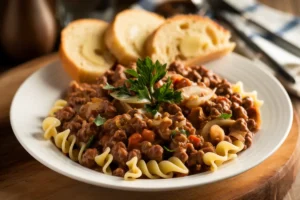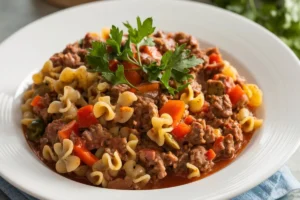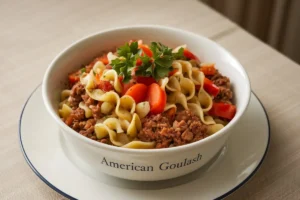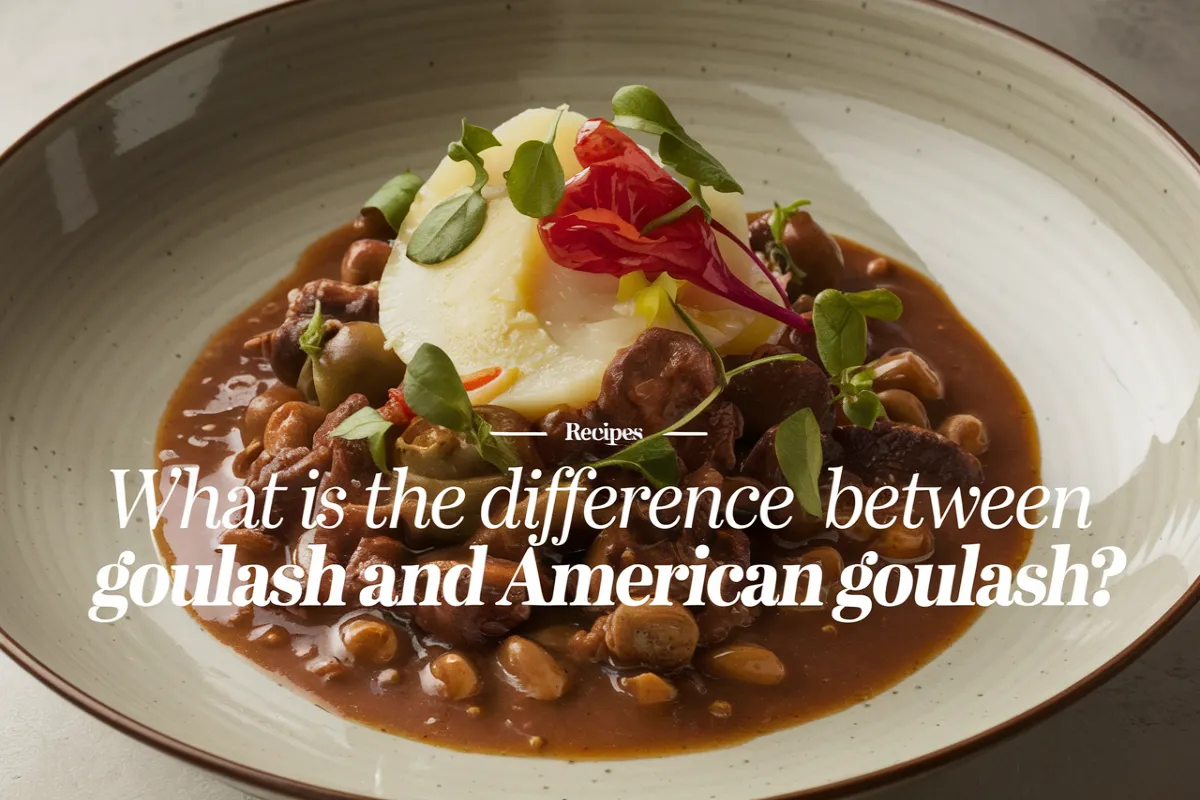What is the Difference Between Goulash and American Goulash?
When you hear the term goulash, you might think of a hearty stew with a rich broth filled with tender chunks of meat, or a comforting pasta dish with ground beef, tomatoes, and macaroni. Both descriptions are accurate, as they refer to two distinct dishes: Hungarian goulash and American goulash. Although they share a name, their ingredients, preparation methods, and cultural backgrounds differ greatly. This article explores the differences between Hungarian goulash and American goulash, highlighting what makes each dish unique.
Understanding the Basics of Goulash
Origins of Hungarian Goulash
Hungarian goulash, or gulyás in Hungary, is a traditional dish with deep historical roots. It originated in the 9th century when Hungarian herdsmen prepared it over open fires. Over time, it became a beloved national stew, rich with the flavors of paprika—a key spice in Hungarian cooking—along with meat, potatoes, and a variety of vegetables.
The dish is more than just food in Hungary; it represents the country’s cultural and culinary heritage. Hungarians often serve goulash at family gatherings, festivals, and national celebrations, preserving a taste of tradition and home. You can learn more about its cultural significance from the National Dish of Hungary.
Emergence of American Goulash
In contrast, American goulash has a different story. It likely developed in the United States in the early 20th century as a quick, budget-friendly meal that could easily adapt to different tastes and available ingredients. Unlike its Hungarian counterpart, American goulash is a one-pot dish made with ground beef, macaroni, and a tomato-based sauce, often flavored with garlic, onions, and bell peppers.
The dish, sometimes called American chop suey, reflects America’s diverse culinary influences, combining elements from various cuisines to create a comforting meal. For more on how American goulash has evolved, check out Authentic Hungarian Recipes.
Key Ingredients and Preparation Differences
The ingredients and preparation methods of Hungarian and American goulash set them apart. Here’s what makes each dish unique.
Ingredients in Hungarian Goulash
- Meat: Typically, Hungarian goulash uses chunks of beef. Pork or lamb can also be used, but beef is most common.
- Vegetables: Onions, bell peppers, potatoes, and sometimes carrots add to the stew’s hearty nature.
- Spices: Paprika is the key spice, giving the dish both color and flavor. Other spices like caraway seeds and garlic enhance the complexity.
- Broth: The broth comes from a mix of meat juices, water, and paprika, creating a flavorful, soup-like consistency.
Hungarians prepare goulash by browning meat with onions, then adding paprika and other spices, followed by vegetables and water. They simmer the stew slowly, allowing the flavors to meld together, creating a rich and satisfying dish.
Ingredients in American Goulash
- Meat: Ground beef is the main protein, which cooks quickly and absorbs the sauce’s flavors.
- Pasta: Macaroni is the traditional choice, giving the dish a unique texture.
- Tomato Base: Tomato sauce or canned tomatoes create a thick, cohesive sauce, unlike the broth of Hungarian goulash.
- Seasoning: The seasoning is simpler, usually including garlic powder, salt, and pepper.
American goulash is easy to make in one pot, which is convenient for busy cooks. The ground beef is browned first, then onions and peppers are added, followed by tomatoes and pasta. The dish simmers until the pasta is tender and the flavors combine.
Texture and Appearance
Hungarian and American goulash also differ in texture and appearance, reflecting their distinct ingredients and preparation methods.
- Hungarian Goulash: This dish resembles a thick soup or stew, with tender chunks of meat and vegetables in a spiced broth. It is often served with bread or noodles to soak up the flavorful broth.
- American Goulash: American goulash looks more like a pasta dish, with ground meat and macaroni in a thick tomato-based sauce. The texture is denser, with the pasta providing a comforting, chewy bite.
Regional Variations and Adaptations

Variations Within Hungary
Hungarian goulash varies across regions. Some versions might include csipetke (small, pinched noodles) for extra texture, while others use different meats or vegetables based on local tastes. Despite these differences, the core elements—meat, paprika, and vegetables—remain the same, preserving the dish’s traditional essence.
American Variations
American goulash is known for its flexibility, making it a staple in many U.S. homes. The dish can be easily customized to fit individual tastes or dietary needs, leading to many regional variations. Some versions add cheese, extra vegetables, or even beans to make the dish more filling. In the Midwest, American goulash might include corn or green beans, while in the South, it might be topped with shredded cheese for added richness.
The dish’s adaptability has made it a popular comfort food, especially in colder months. Whether served at family dinners, potlucks, or community gatherings, American goulash continues to be a versatile dish that reflects the diversity of American cuisine.
Cultural Significance
Hungarian Goulash in Hungarian Culture
For many in Hungary, goulash is more than just a dish; it is a symbol of national pride and heritage. People often prepare and enjoy it during holidays, family gatherings, and special events, showcasing its importance in Hungarian society. Goulash also appears in Hungarian literature, folklore, and art, further solidifying its status as a national treasure.
American Goulash in American Culture
In the U.S., American goulash holds a special place as a comforting, easy-to-make dish that brings people together. It often evokes childhood memories, family dinners, and community meals, creating a sense of nostalgia and home. The dish’s simplicity and versatility make it a popular choice for busy families and anyone looking for a quick, satisfying meal.
American goulash also reflects America’s diverse culinary landscape, blending different cultural elements into a dish that is both familiar and comforting. Its popularity shows its ability to adapt to changing tastes and lifestyles, making it a beloved part of American food culture.
Nutritional Comparison
Both Hungarian and American goulash are hearty and satisfying, but they differ in their nutritional content due to their ingredients and preparation methods.
Hungarian Goulash: A Balanced Stew
- Calories: Hungarian goulash usually has fewer calories than American goulash because it does not include pasta.
- Protein: Chunks of meat provide a good source of protein, making it a nutritious option.
- Fat: The fat content varies depending on the meat used. Leaner cuts of beef or pork can reduce fat, making it a healthier choice.
- Carbohydrates: The carbohydrate content is low, as the dish relies on vegetables and meat rather than pasta.
American Goulash: A Comforting Pasta Dish

- Calories: American goulash is generally higher in calories due to the inclusion of pasta and often cheese.
- Protein: Ground beef offers protein, but the overall protein content might be lower if less meat is used.
- Fat: The fat content can be higher, especially with fattier meats or added cheese.
- Carbohydrates: The pasta significantly increases the carbohydrate content, making it more energy-dense.
Both dishes can be made healthier by choosing lean meats, whole grain pasta, and adding more vegetables.
Frequently Asked Questions (FAQs)
1. What is the primary difference between Hungarian and American goulash?
The main difference is in their ingredients and preparation. Hungarian goulash is a stew made with chunks of meat, vegetables, and paprika, creating a rich broth. American goulash is a pasta dish with ground beef, macaroni, and a tomato-based sauce, resulting in a different texture and flavor.
2. Can you substitute American goulash ingredients for Hungarian goulash?
While some ingredients can be swapped, doing so will create a different dish. Using ground beef and pasta instead of chunks of meat and vegetables will result in something closer to American goulash, missing the distinctive flavor and texture of Hungarian goulash.
3. Is goulash considered a soup or a stew?
Hungarian goulash is usually considered a stew due to its thick consistency and hearty ingredients, though it can also be served as a soup with more broth. American goulash is generally viewed as a pasta dish because of its thicker, sauce-like consistency and the inclusion of macaroni.
4. What is the origin of the word “goulash”?
The word “goulash” comes from the Hungarian word “gulyás,” meaning herdsman. Originally, cattle herders cooked it over open fires while tending their flocks, leading to its association with hearty, rustic cooking.
5. Are there vegetarian versions of goulash?
Yes, both Hungarian and American goulash can be made vegetarian by substituting meat with plant-based proteins like beans, lentils, or mushrooms. In Hungarian goulash, vegetable stock can replace meat broth, and extra vegetables can be added for flavor and texture. In American goulash, ground beef can be replaced with a meat substitute, and more vegetables can make a satisfying, meatless version.
6. How can you make American goulash healthier?
To make American goulash healthier, use whole wheat pasta to increase fiber content. Choose lean ground meat or a plant-based substitute to cut fat. Add more vegetables, like bell peppers, zucchini, or spinach, to boost nutrition. Reducing cheese or using a low-fat variety can also lower calories and fat.

Conclusion
In summary, while Hungarian goulash and American goulash share a name, they are distinct dishes that reflect their unique cultural traditions. Hungarian goulash is a traditional stew rich in flavor, with paprika, chunks of meat, and vegetables. American goulash, by contrast, is a modern, pasta-based dish that has become a staple of comfort food in the United States, valued for its simplicity and versatility.
Understanding the differences between these dishes allows you to appreciate their unique qualities. Whether you enjoy the hearty flavors of Hungarian goulash or the comforting appeal of American goulash, both dishes offer something special. Try making both at home to experience their diverse tastes and textures.

